
Portugal is a coastal nation in western Europe, located at the western end of the Iberian Peninsula, bordering Spain. The Portuguese territory also includes a series of archipelagos in the Atlantic Ocean, which are strategic islands along the North Atlantic. The extreme south is not too far from the Strait of Gibraltar, leading to the Mediterranean Sea. In total, the country occupies an area of 92,090 square kilometres (35,560 sq mi) of which 91,470 square kilometres (35,320 sq mi) is land and 620 square kilometres (240 sq mi) water.

The tree ferns are arborescent (tree-like) ferns that grow with a trunk elevating the fronds above ground level, making them trees. Many extant tree ferns are members of the order Cyatheales, to which belong the families Cyatheaceae, Dicksoniaceae, Metaxyaceae, and Cibotiaceae. It is estimated that Cyatheales originated in the early Jurassic, and is the third group of ferns known to have given rise to tree-like forms. The others are the extinct Tempskya of uncertain position, and Osmundales where the extinct Guaireaceae and some members of Osmundaceae also grew into trees. In addition there were the Psaroniaceae and Tietea in the Marattiales, which is the sister group to most living ferns including Cyatheales.

Macaronesia is a collection of four volcanic archipelagos in the North Atlantic, off the coasts of Africa and Europe. Each archipelago is made up of a number of Atlantic oceanic islands, which are formed by seamounts on the ocean floor whose peaks have risen above the ocean's surface.
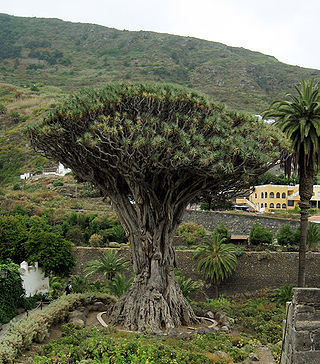
Dracaena draco, the Canary Islands dragon tree or drago, is a subtropical tree in the genus Dracaena, native to the Canary Islands, Cape Verde, Madeira, western Morocco, and possibly introduced into the Azores.

Laurel forest, also called laurisilva or laurissilva, is a type of subtropical forest found in areas with high humidity and relatively stable, mild temperatures. The forest is characterized by broadleaf tree species with evergreen, glossy and elongated leaves, known as "laurophyll" or "lauroid". Plants from the laurel family (Lauraceae) may or may not be present, depending on the location.

The Azores bullfinch, also known as the São Miguel bullfinch, or locally in Portuguese as the priolo, is a threatened passerine bird in the true finch family. It is endemic to São Miguel Island, in the Azores archipelago of Macaronesia in the North Atlantic Ocean.

Myrica faya is a species of Myrica, native to Macaronesia, and possibly also western coastal mainland Portugal.

The woodlands of the Iberian Peninsula are distinct ecosystems on the Iberian Peninsula. Although the various regions are each characterized by distinct vegetation, the borders between these regions are not clearly defined, and there are some similarities across the peninsula.

Laurus azorica, the Azores laurel or Macaronesian laurel, is a small, evergreen tree in the laurel family (Lauraceae), found only on the Azores island group in the North Atlantic.

Quercus lusitanica, commonly known as gall oak, Lusitanian oak, or dyer's oak, is a species of oak native to Portugal, Spain and Morocco. Quercus lusitanica is the source of commercial nutgalls. These galls are produced by the infection from the insect Cynips gallae tinctoriae. They are used for dyeing.
Pico da Vara is the highest mountain on the island of São Miguel, in the Portuguese archipelago of the Azores, and principal special protection of the Nature Reserve of Pico da Vara. The area around the mountain includes the largest remaining stand of the native laurisilva forest on the island, home to the critically endangered endemic Azores bullfinch.
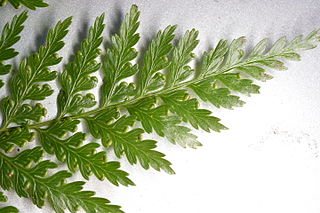
Culcita is a genus of ferns, native to the Americas, Macaronesia and Iberian Peninsula. It is the only genus in the family Culcitaceae in the Pteridophyte Phylogeny Group classification of 2016. Alternatively, the family may be treated as the subfamily Culcitoideae of a very broadly defined family Cyatheaceae, the placement used for the genus in Plants of the World Online as of November 2019.

Quercus rotundifolia, the holm oak or ballota oak, is an evergreen oak native to the western Mediterranean region, with the majority on the Iberian Peninsula and minor populations in Northwest Africa. The species was first described by Jean-Baptiste Lamarck in 1785. It is the typical species of the Iberian dehesa or montado, where its sweet-astringent acorns are a source of food for livestock, particularly the Iberian pig. Its acorns have been used for human nourishment since the Neolithic era. It is placed in section Ilex. Some authors described it as a subspecies of Quercus ilex.

Asplenium adiantum-nigrum is a common species of fern known by the common name black spleenwort. It is found mostly in Africa, Europe, and Eurasia, but is also native to a few locales in Mexico and the United States.

Davallia canariensis, the hare's-foot fern, is a species of fern in the family Davalliaceae. It is endemic to Macaronesia and the Iberian Peninsula. It grows well in a sunny atmosphere and amongst rocks.
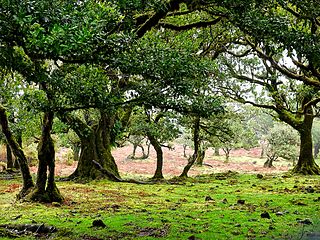
The Madeira evergreen forests is a laurissilva ecoregion of southwestern Europe. It covers the archipelago of Madeira and some nearby islands in the Atlantic Ocean. Laurel forest, known as Laurisilva of Madeira, once covered the islands. Over centuries the laurel forests were mostly cleared. Madeira's remaining forests are now protected.
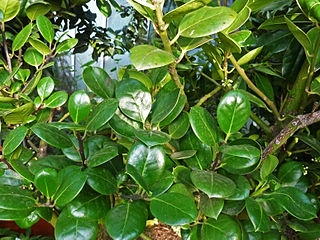
Ilex perado, the Macaronesian holly, is a species of holly endemic to Macaronesia, distributed throughout the Azores, Madeira and Canary islands. It is an important component of the natural high-altitude Macaronesian rainforest, known as 'laurisilva', found mostly at 500 to 1,200 m altitude but it also appears in forest formations at lower elevation. Many of the subspecies have been classified as threatened, probably because of very small population sizes, and are protected by local, national and regional legislation.
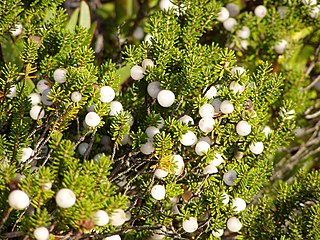
Corema album, the Portuguese crowberry ; Spanish: camarina, is a species of flowering plant in the family Ericaceae endemic to the Iberian Peninsula, Aquitaine, and the Azores (sub-species), where it may also be considered a different species. Its white berries are known to have been consumed by people in the Iberian Peninsula at least since the Middle-Ages. The only other species of the same genus is Corema conradii, found in North America.

Polystichum drepanum, also known as Madeira shield-fern, is a species of fern in the Dryopteridaceae family.

Portugal is located on the Mediterranean Basin, the third most diverse hotspot of flora in the world. Due to its geographical and climatic context - between the Atlantic and Mediterranean - Portugal has a high level of biodiversity on land and at sea. It is home to six terrestrial ecoregions: Azores temperate mixed forests, Cantabrian mixed forests, Madeira evergreen forests, Iberian sclerophyllous and semi-deciduous forests, Northwest Iberian montane forests, and Southwest Iberian Mediterranean sclerophyllous and mixed forests. Over 22% of its land area is included in the Natura 2000 network, including 62 special conservation areas and 88 types of protected landscape natural habitats.





















